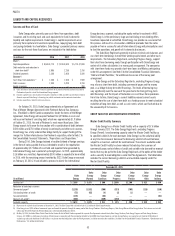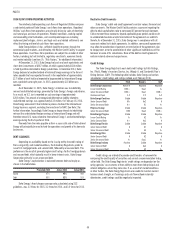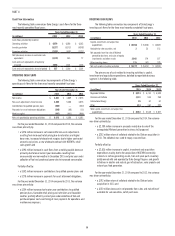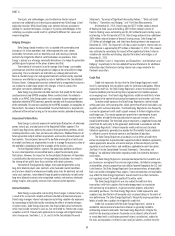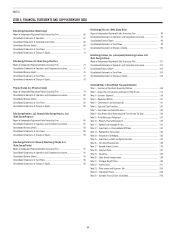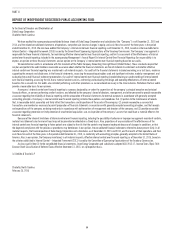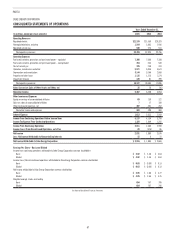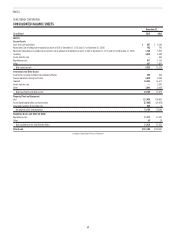Duke Energy 2015 Annual Report Download - page 83
Download and view the complete annual report
Please find page 83 of the 2015 Duke Energy annual report below. You can navigate through the pages in the report by either clicking on the pages listed below, or by using the keyword search tool below to find specific information within the annual report.
63
PART II
Court granted the EPA’s request to keep the rule in effect while the agency
completes the rulemaking in response to the Supreme Court’s ruling. On
December 1, 2015, the EPA proposed a supplemental finding to address the
cost issue raised by the Supreme Court in its June 2015 ruling. If finalized as
proposed, the finding would result in no changes to the current MATS regulatory
requirements. The EPA has committed to complete its rulemaking by April 2016.
The Duke Energy Registrants cannot predict the results of these proceedings.
Clean Water Act 316(b)
The EPA published the final 316(b) cooling water intake structure rule on
August 15, 2014, with an effective date of October 14, 2014. The rule applies
to 26 of the electric generating facilities the Duke Energy Registrants own and
operate. The rule allows for several options to demonstrate compliance and
provides flexibility to the state environmental permitting agencies to make
determinations on controls, if any, that will be required for cooling water intake
structures. Any required intake structure modifications and/or retrofits are
expected to be installed in the 2019 to 2022 time frame. Petitions challenging
the rule have been filed by several groups. It is unknown at this time when the
courts will rule on the petitions.
Steam Electric Effluent Limitations Guidelines
On January 4, 2016, the final Steam Electric Effluent Limitations
Guidelines (ELG) rule became effective. The rule establishes new requirements
for wastewater streams associated with steam electric power generation and
includes more stringent controls for any new coal plants that may be built in
the future. Affected facilities must comply between 2018 and 2023, depending
on timing of new Clean Water Act permits. Most, if not all, of the steam electric
generating facilities the Duke Energy Registrants own are likely affected sources.
The Duke Energy Registrants are well-positioned to meet the requirements of the
rule due to current efforts to convert to dry ash handling. Petitions challenging
the rule have been filed by several groups. It is unknown at this time when the
courts will rule on the petitions.
Estimated Cost and Impacts of Rulemakings
Duke Energy will incur capital expenditures to comply with the
environmental regulations and rules discussed above. The following five-year
table provides estimated costs, excluding AFUDC, of new control equipment that
may need to be installed on existing power plants primarily to comply with the
Coal Ash Act requirements for conversion to dry disposal of bottom ash and fly
ash, MATS, Clean Water Act 316(b) and ELGs, through December 31, 2020. The
table excludes ash basin closure costs recorded as Asset retirement obligations
on the Consolidated Balance Sheets. For more information related to asset
retirement obligations, see Note 9 to the Consolidated Financial Statements.
(in millions) Five-Year Estimated Costs
Duke Energy $ 1,350
Duke Energy Carolinas 625
Progress Energy 350
Duke Energy Progress 300
Duke Energy Florida 50
Duke Energy Ohio 100
Duke Energy Indiana 275
The Duke Energy Registrants also expect to incur increased fuel,
purchased power, operation and maintenance and other expenses, in
addition to costs for replacement generation for potential coal-fired power
plant retirements, as a result of these regulations. Actual compliance costs
incurred may be materially different from these estimates due to reasons
such as the timing and requirements of EPA regulations and the resolution of
legal challenges to the rules. The Duke Energy Registrants intend to seek rate
recovery of necessary and prudently incurred costs associated with regulated
operations to comply with these regulations.
Cross-State Air Pollution Rule
On August 8, 2011, the final Cross-State Air Pollution Rule (CSAPR) was
published in the Federal Register. The CSAPR established state-level annual
sulfur dioxide (SO2) budgets and annual and seasonal nitrogen oxide (NOx)
budgets that were to take effect on January 1, 2012.
On August 21, 2012, the D.C. Circuit Court vacated the CSAPR. The court
also directed the EPA to continue administering the Clean Air Interstate Rule
(CAIR), which required additional reductions in SO2 and NOX emissions beginning
in 2015. On April 29, 2014, the U.S. Supreme Court (Supreme Court) reversed
the D.C. Circuit Court’s decision, finding that with CSAPR the EPA reasonably
interpreted the good neighbor provision of the CAA. The case was remanded
to the D.C. Circuit Court for further proceedings consistent with the Supreme
Court’s opinion. On October 23, 2014, the D.C. Circuit Court lifted the CSAPR
stay, which allowed Phase 1 of the rule to take effect on January 1, 2015,
terminating the CAIR. Where the CSAPR requirements are constraining, actions
to meet the requirements could include purchasing emission allowances, power
purchases, curtailing generation and utilizing low sulfur fuel. The CSAPR will not
result in Duke Energy Registrants adding new emission controls.
Additional legal challenges to the CSAPR filed in 2012, not addressed
by the D.C. Circuit Court decision to vacate the CSAPR, are still ongoing. Oral
arguments were held February 25, 2015. On July 28, 2015, the court issued
decisions finding certain Phase 1 and 2 emissions budgets invalid, which impact
South Carolina, North Carolina and Florida. The court remanded the CSAPR to
the EPA for reconsideration of the budgets in question. On December 3, 2015,
the EPA proposed a rule to lower the current CSAPR Phase 2 state ozone season
NOX emission budgets for 23 Eastern states, including North Carolina, Ohio,
Kentucky and Indiana. The EPA also proposed to eliminate the CSAPR Phase
2 ozone season state NOX budgets for Florida and South Carolina. The EPA
proposed that these changes to state budgets take effect on May 1, 2017. The
Duke Energy Registrants cannot predict the outcome of these proceedings.
Carbon Pollution Standards for New, Modified and
Reconstructed Power Plants
On October 23, 2015, the EPA published a final rule in the Federal Register
establishing carbon dioxide (CO2) emissions limits for new, modified and
reconstructed power plants. The requirements for new plants do not apply to
any facility that Duke Energy currently has in operation, but would apply to any
plants that will be constructed going forward. The EPA set an emissions standard
for coal units of 1,400 lbs. of CO2 per gross MWh. While this limit is higher than
the EPA’s proposed standard of 1,100 lbs. per MWh, it would still require the
application of partial carbon capture and storage (CCS) technology for a coal unit
to be able to meet the limit. Utility-scale CCS is not currently a demonstrated
and commercially available technology for coal-fired electric generating units,
and therefore the final standard effectively bars the development of new
coal-fired generation. The final standard of 1,000 lbs. of CO2 per gross MWh for
new natural gas combined-cycle units is the same as the proposed limit. The
Duke Energy Registrants do not expect the impacts of the final standards will be
material to Duke Energy’s financial position, results of operations or cash flows.
Clean Power Plan
On October 23, 2015, the EPA published in the Federal Register the CPP
rule that regulates CO2 emissions from existing fossil fuel-fired EGUs. The
CPP establishes CO2 emission rates and mass cap goals that apply to fossil
fuel-fired generation. Under the CPP, states are required to develop and submit
a final compliance plan, or an initial plan with an extension request, to the EPA
by September 6, 2016. States that receive an extension must submit a final
completed plan to the EPA by September 6, 2018. The EPA intends to review and
approve or disapprove state plans within 12 months of receipt. The CPP does
not directly impose regulatory requirements on the Duke Energy Registrants.


